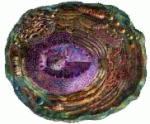Cell Biology
|
1 november 2014 05:52:27 |
| Genetic and biochemical approaches towards unravelling the degradation of gallotannins by Streptococcus gallolyticus (Microbial Cell Factories) |
|
Tweet Background:
Herbivores have developed mechanisms to overcome adverse effects of dietary tannins through the presence of tannin-resistant bacteria. Tannin degradation is an unusual characteristic among bacteria. Streptococcus gallolyticus is a common tannin-degrader inhabitant of the gut of herbivores where plant tannins are abundant. The biochemical pathway for tannin degradation followed by S. gallolyticus implies the action of tannase and gallate decarboxylase enzymes to produce pyrogallol, as final product. From these proteins, only a tannase (TanBSg) has been characterized so far, remaining still unknown relevant proteins involved in the degradation of tannins.
Results:
In addition to TanBSg, genome analysis of S. gallolyticus subsp. gallolyticus strains revealed the presence of an additional protein similar to tannases, TanASg (GALLO_0933). Interestingly, this analysis also indicated that only S. gallolyticus strains belonging to the subspecies ?gallolyticus? possessed tannase copies. This observation was confirmed by PCR on representative strains from different subspecies. In S. gallolyticus subsp. gallolyticus the genes encoding gallate decarboxylase are clustered together and close to TanBSg, however, TanASg is not located in the vicinity of other genes involved in tannin metabolism. The expression of the genes enconding gallate decarboxylase and the two tannases was induced upon methyl gallate exposure. As TanBSg has been previously characterized, in this work the tannase activity of TanASg was demonstrated in presence of phenolic acid esters. TanASg showed optimum activity at pH?6.0 and 37?C. As compared to the tannin-degrader Lactobacillus plantarum strains, S. gallolyticus presented several advantages for tannin degradation. Most of the L. plantarum strains possessed only one tannase enzyme (TanBLp), whereas all the S. gallolytcius subsp. gallolyticus strains analyzed possesses both TanASg and TanBSg proteins. More interestingly, upon methyl gallate induction, only the tanB
Lp
gene was induced from the L. plantarum tannases; in contrast, both tannase genes were highly induced in S. gallolyticus. Finally, both S. gallolyticus tannase proteins presented higher activity than their L. plantarum counterparts.
Conclusions:
The specific features showed by S. gallolyticus subsp. gallolyticus in relation to tannin degradation indicated that strains from this subspecies could be considered so far the best bacterial cellular factories for tannin degradation. |
| 90 viewsCategory: Microbiology, Cell Biology |
 Changes in SAM 2 expression affect lactic acid tolerance and lactic acid production in Saccharomyces cerevisiae (Microbial Cell Factories) Changes in SAM 2 expression affect lactic acid tolerance and lactic acid production in Saccharomyces cerevisiae (Microbial Cell Factories)Metabolomic basis of laboratory evolution of butanol tolerance in photosynthetic Synechocystis sp. PCC 6803 (Microbial Cell Factories) 
|
| blog comments powered by Disqus |
MyJournals.org
The latest issues of all your favorite science journals on one page
The latest issues of all your favorite science journals on one page



